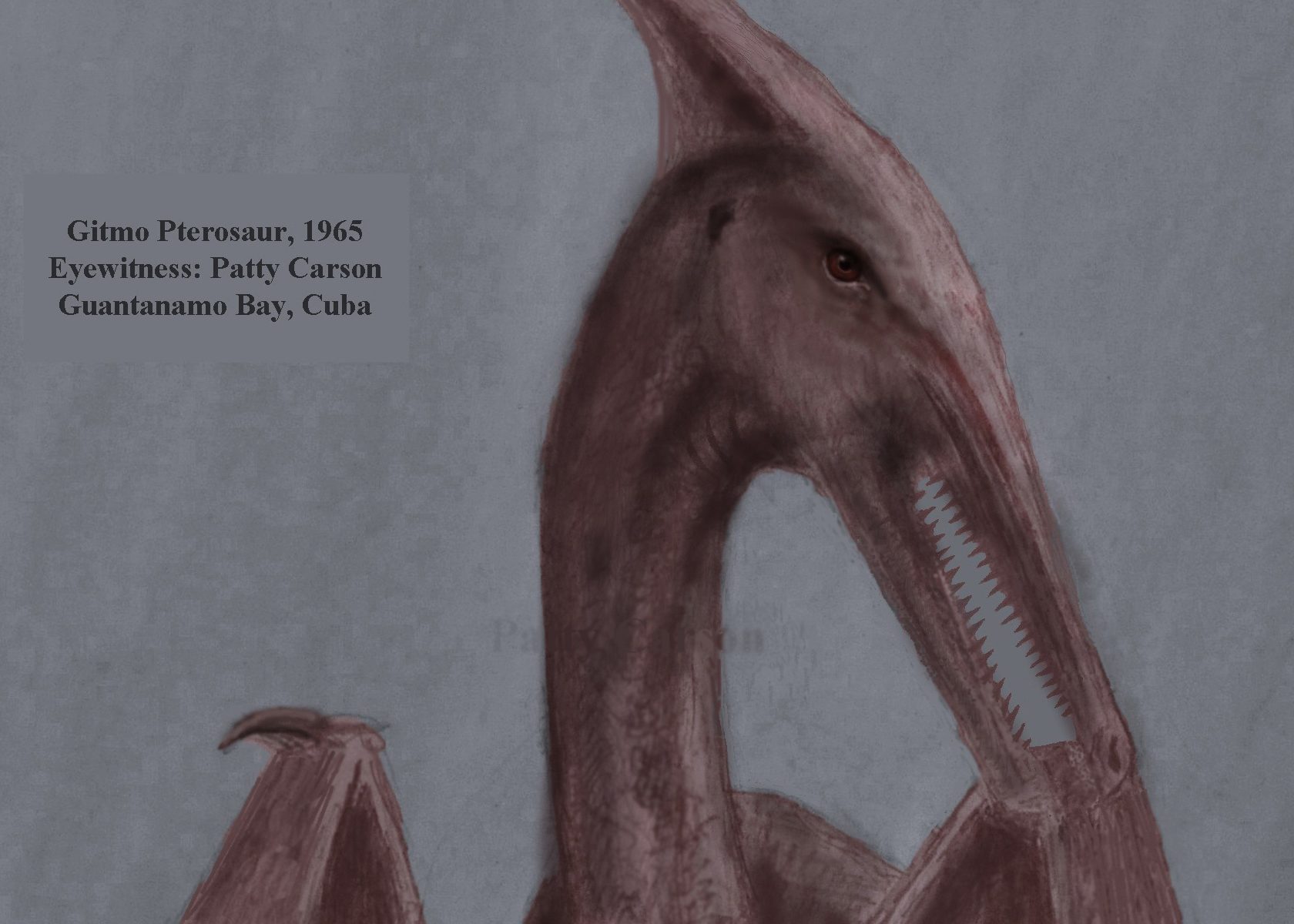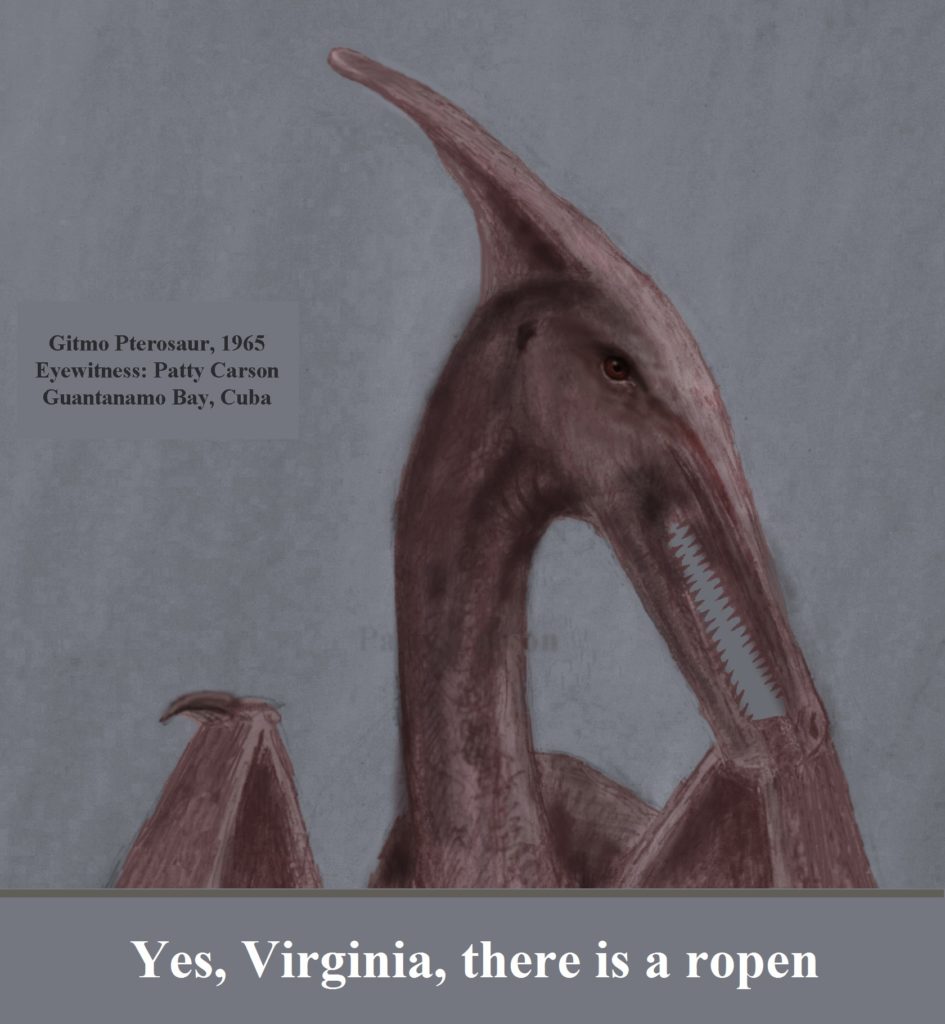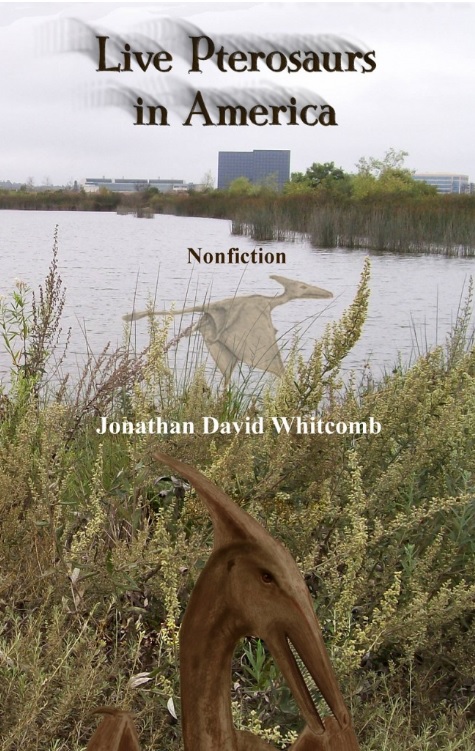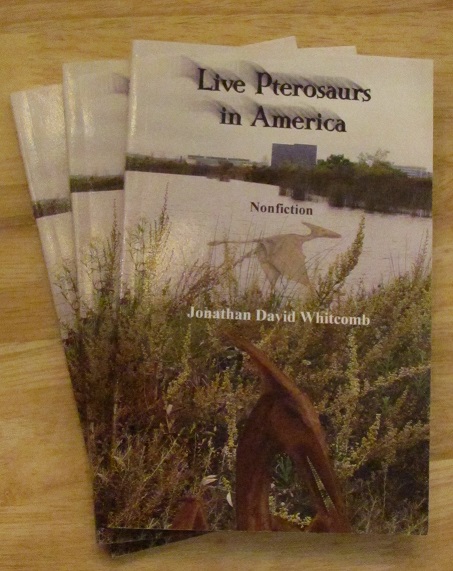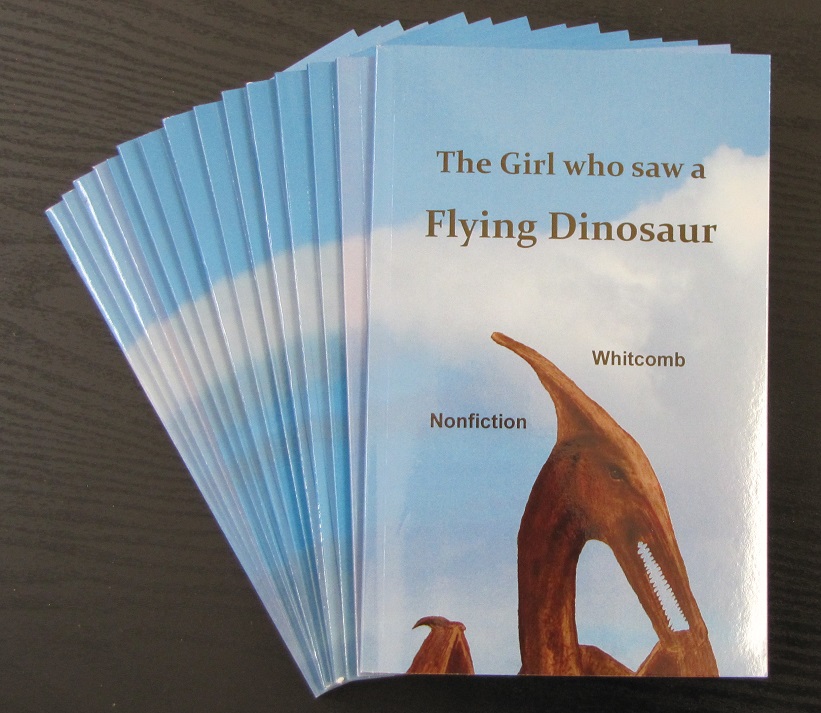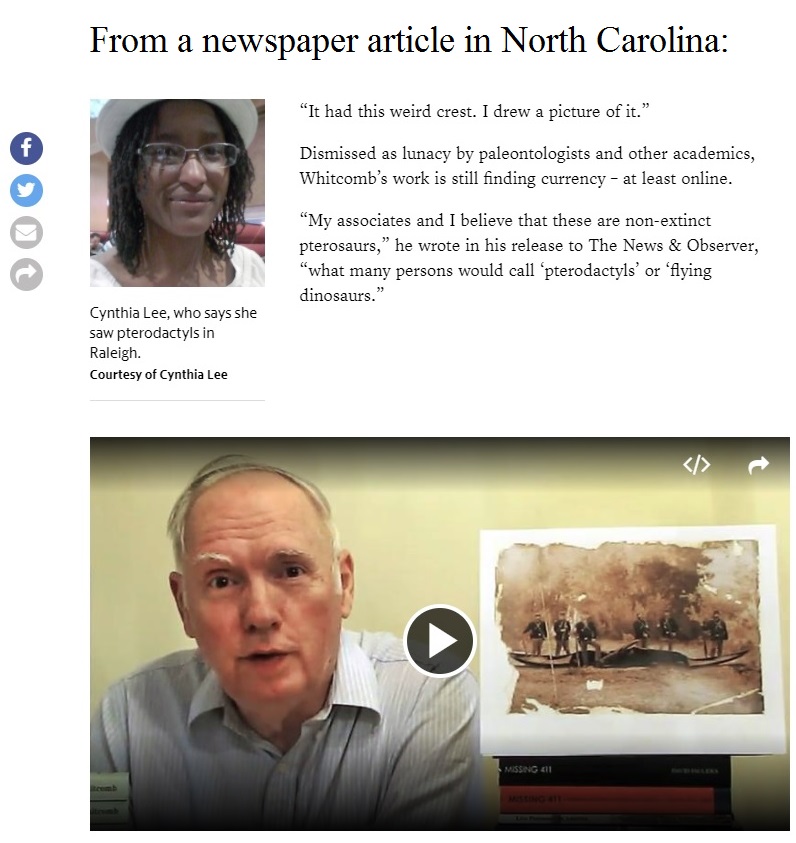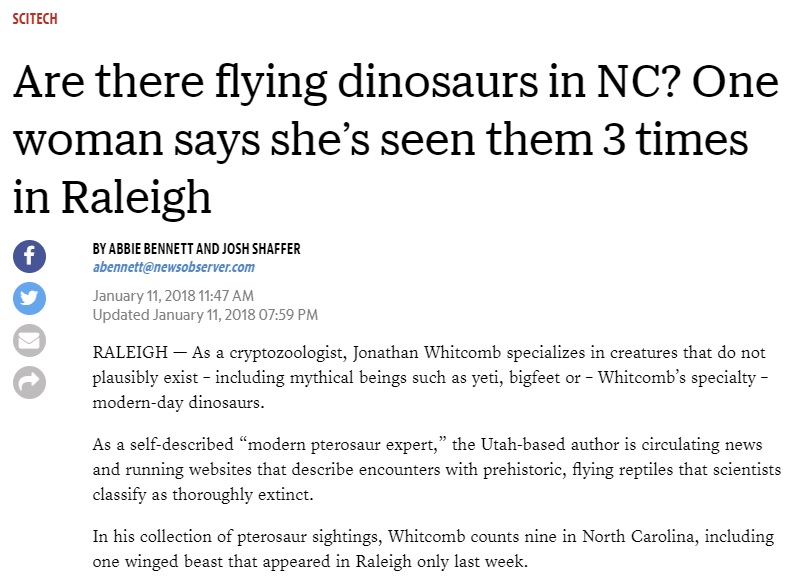By the investigative journalist Jonathan David Whitcomb
Introduction
I now respond to countless cries from children around the world, calling out for answers, crying out for help as they try to understand why all dinosaurs must have become extinct many millions of years ago. Consider one answer: the new nonfiction book for kids and young teens: The Girl who saw a Flying Dinosaur. Now consider another answer below.
This is about an animal that people around the world have seen, a creature whose page was deleted from the English Wikipedia in August of 2014, apparently after a few persons became offended because of what they thought about the religious beliefs of some of the American explorers who had searched for that animal in Papua New Guinea. This nocturnal flying creature is the ropen. I am one of those explorers.
The ropen is not any species of dinosaur, in the strict scientific sense: It’s a long-tailed pterosaur, according to some cryptozoologists, what many people in earlier human history would have called a dragon. Many Westerners, some of them eyewitnesses, now call it a pterodactyl.
An old Newspaper Editorial
What is the most famous newspaper editorial in history? The one most often reprinted seems to be “Yes, Virginia, There is a Santa Claus.” Here is the untouched first paragraph of that editorial, which was published on September 21, 1897, in New York’s Sun. I suggest reading this within a new light: Let “your little friends” refer to all those who dogmatically insist that all species of dinosaurs and pterosaurs must have become extinct many millions of years ago. Let “Virginia” be every child who asks, “Why did they all die?”
VIRGINIA, your little friends are wrong. They have been affected by the skepticism of a skeptical age. They do not believe except they see. They think that nothing can be which is not comprehensible by their little minds. All minds, Virginia, whether they be men’s or children’s, are little. In this great universe of ours man is a mere insect, an ant, in his intellect, as compared with the boundless world about him, as measured by the intelligence capable of grasping the whole of truth and knowledge.
Adapting the old Newspaper Editorial
Yes, VIRGINIA, there is a ropen. He exists as certainly as birds and butterflies exist, and you know that they abound and give to your life great beauty and joy. The sketch of the ropen, drawn by Patty Carson, who was only about six years old when she saw that “pterodactyl,” may look frightening, yet consider what Patty told me decades later, when she was a grownup: It did not attack the children but quickly flew away from them. Maybe it was afraid of people.
Alas! how dreary would be the world if all the professors needed only to imagine that all species of a particular type were extinct, and—POOF—all of them instantaneously died! Add to that idea an apparent time machine, which takes that extinction back millions of years, be it 65-million or 66-million. How tragic if those professors actually had that kind of power!
Not believe in the ropen! You might as well not believe in the platypus! (I don’t remember the last time I saw one of those; it must have been in a zoo.) Keep in mind that the word strange is non synonymous with impossible. If your little friends told you that the ropen cannot be real because its head crest is like that of a Pterodactyloid yet its tail is like that of a Rhamphorhynchoid, remind them of the mammal having a mouth like a duck’s bill.
I recall one skeptic who declared that no Rhamphorhynchoid ever had a head crest. What nonsense! Paleontologists know about at least two species of Rhamphorhynchoid pterosaurs that had some kind of head crest. And what about the countless long-tailed pterosaurs that never left a fossil, and what about all of them that left fossil evidence that has not yet been discovered?
Remind your little friends, Virginia, of what they believed in many years ago: Santa Claus. As children grow older, they realize they’ve never seen him and none of their friends have seen him. I suggest that’s about the time your little friends began to doubt the stories of Santa.
The ropen, however, flies circles around all those stories about flying reindeer. I’ve never heard about any person, not even one human, who has reported observing Santa Claus in a sleigh being pulled around the world by those animals. Yet over the past 15 years, hundreds of persons from around the world have reported to me that they had observed a living pterosaur.
Not believe in the ropen! Let me tell you part of why I believe. Among all the emails eyewitnesses have sent me, some of them tell me something else. It’s not nearly half of the eyewitnesses; perhaps less than 15%. Yet a significant minority of them tell me about another person who has seen a real living pterosaur. I’m not talking about somebody standing or sitting next to the person at the time of that sighting: I mean a friend or family member who had a different sighting of a modern pterosaur, on a different day and usually in a different place. The implication is huge.
I admit my calculations are crude; I could have missed the mark. If I am correct, however, the number of persons now living in the United States who have had a clear view of an obvious living pterosaur is between 50,000 and 4,000,000. Even taking the lowest figure and assuming I have made an error making it only 10% as many as I have figured, we have 5,000 persons now living in the United States, with each of those persons getting a view good enough to see a flying creature obviously appearing to be a “pterodactyl.”
Yes, Virginia, there is a ropen, and I believe in this animal. If we could get millions of people to search in every bush and hole on the planet, trying to see a ropen, what would that prove? The searchers with closed minds and fear of ridicule, perhaps like your little friends—they might not report finding any ropen, even if they had seen one. And what about those who did report finding a ropen? How would they differ from the hundreds of persons who have already told me about their encounters with living pterosaurs?
Please, Virginia, believe in what the eyewitnesses have already told us. Even though you and I have not seen a ropen, we can perceive it through the eyes of other persons who’ve been more fortunate.
Not believe in the ropen! Thank God this animals lives! Whatever some people think about Santa Claus or about mass extinctions of general types of animals millions of years ago, the ropen will continue to fly through the sky, albeit mostly unseen at night. I pray that knowing about this uncommon creature will lift the hearts of children and of teenagers and adults around the world. What a wonder God has given us! The supposedly oldest of pterosaur types is still flying over our heads at night, calling for us to rise above those dogmas that have long held us down.
Believe in the ropen, Virginia, and in your heart fly with him above villages, lakes, cities, and oceans, above mountains, deserts, plains, and jungles. I’ll be flying by your side.
###
.
Introduction to an apparent modern pterosaur
.
Yes, Virginia, There is a Santa Claus
Eight-year-old Virginia O’Hanlon wrote a letter to the editor of New York’s Sun, and the quick response was printed as an unsigned editorial Sept. 21, 1897. The work of veteran newsman Francis Pharcellus Church has since become history’s most reprinted newspaper editorial, appearing in part or whole in dozens of languages in books, movies, and other editorials, and on posters and stamps.
.
If apparent pterosaurs observed in Virginia are not the same species as the flying creature called “Gitmo Pterosaur” or “American Hammerhead Ropen,” it may at least be a closely-related species. I recently got another report from Virginia: a sighting just a few days ago in Richmond.
.
How many Americans have seen a living pterosaur?
For the moment, we’ll have to be content with a general range. It seems that between 50,000 and 4,000,000 Americans have seen an obvious pterosaur at some time in their human lifespans. It certainly cannot be much below that minimum or much above that maximum.
.
Notice the above two sketches: both heads have long pointed head crests. The top image was chosen by Hennessy; the bottom, by Hodgkinson. This does not prove those flying creatures of the southwest Pacific were the same species as the ones flying in Cuba, but it does suggest a similar type.
.
The actual number of humans now living worldwide, who have encountered one of these flying creatures, has been estimated, by Jonathan David Whitcomb, at between 7 million and 128 million. That is a conservative estimate, but it includes all encounters, and many of those were brief and at night and many were not recognized by the eyewitnesses as significant or involving anything unusual . . .
.
Many natives living on the tropical island of Umboi (Siasi), Papua New Guinea, have seen the flying light, the bioluminescent glow of the ropen.
.



